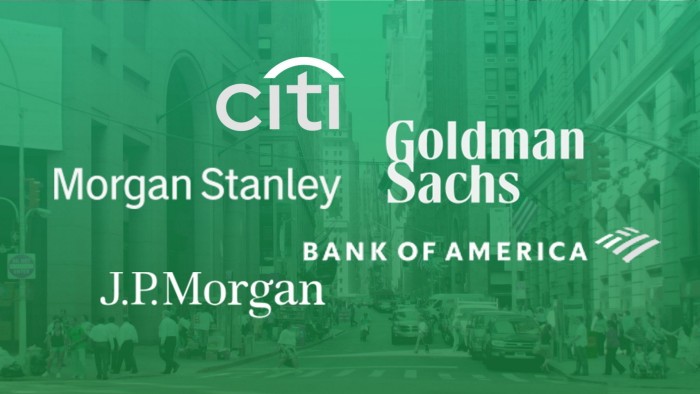Share this @internewscast.com
Stay informed with free updates
Investment banking is set to continue its trend of poor performance, contributing to less than 25% of the revenue at major US banks on Wall Street for the 14th consecutive quarter.
Traders are anticipated to support their advisory counterparts once again when banks announce their second-quarter earnings next week, with trading revenues from the five largest Wall Street banks expected to reach $31 billion — more than triple the amount generated by investment banking.
Experts predict that trading revenues for JPMorgan Chase, Bank of America, Citigroup, Goldman Sachs, and Morgan Stanley will rise by nearly 10% compared to the previous year.
They forecast that revenues from investment banking, the other part of the banks’ Wall Street operations, will fall almost 10 per cent to $7.5bn, according to consensus data compiled by Bloomberg.
If the earnings match estimates when the groups report results on Tuesday and Wednesday, investment bankers will have contributed less than 25 per cent of Wall Street revenues — distinct from money earned from retail banking and money management activities — since the start of 2022.
This would be the longest period in which they have failed to breach that threshold since at least 2014.

Although trading and investment banking are both volatile businesses, the length of the latter’s downturn highlights how quiet dealmaking and equity capital markets have been since the bursting of the 2021 pandemic-era bubble.
It also underlines how strong the trading business has been following a moribund period in the 2010s, when low interest rates and muted volatility held down revenues.
Banks facilitate and finance trades. They benefit when activity levels are high and prices are volatile.
“This is a normal environment, whereas the low [volatility] environment of the 2010s was the abnormal part,” said Chris Kotowski, research analyst at Oppenheimer & Co.
In the past three years, financial markets have grappled with rising interest rates, conflicts in Ukraine and the Middle East, and protectionist policies after Donald Trump’s return to the White House.
These same trends have damped the ability of company leaders and investment firms to do deals, despite continued optimism from bankers about the potential pipeline.
“I think 2025 is more or less done [for investment banking],” Kotowski said. “Yes you could get a strong quarter of equity issuance in the fall, and that would help numbers. The M&A is going to be more a function of what’s been announced already for the back half of the year.”
Investors tend to value revenues from investment banking more highly than trading because it can be higher margin and less capital-intensive.
Investors are still betting that the long-anticipated recovery in investment banking will materialise, with Goldman’s stock price recently surpassing $700 for the first time.
“The first half of the quarter was rough for obvious reasons. But there’s obviously a lot more optimism about the outlook here,” said HSBC banking analyst Saul Martinez.
The same political and economic stability that investors hope will grease the wheels for deals could ease the market volatility that has buoyed banks’ trading revenues.
Revenue from trading “has been really elevated and I don’t know that you can make the case convincingly that you’re going to see a lot of growth from here”, said Martinez.
JPMorgan and Citi report results on July 15, with BofA, Goldman and Morgan Stanley reporting the following day.
Along with Wells Fargo, the group represents the six largest US banks by assets. Net income for the six banks overall is expected to fall about 13 per cent from the same quarter last year.
The steepest drop is likely to be at JPMorgan, with analysts predicting a decline of 30 per cent from a year ago, when the bank recorded a one-off gain of almost $8bn from its stake in the credit card company Visa.






